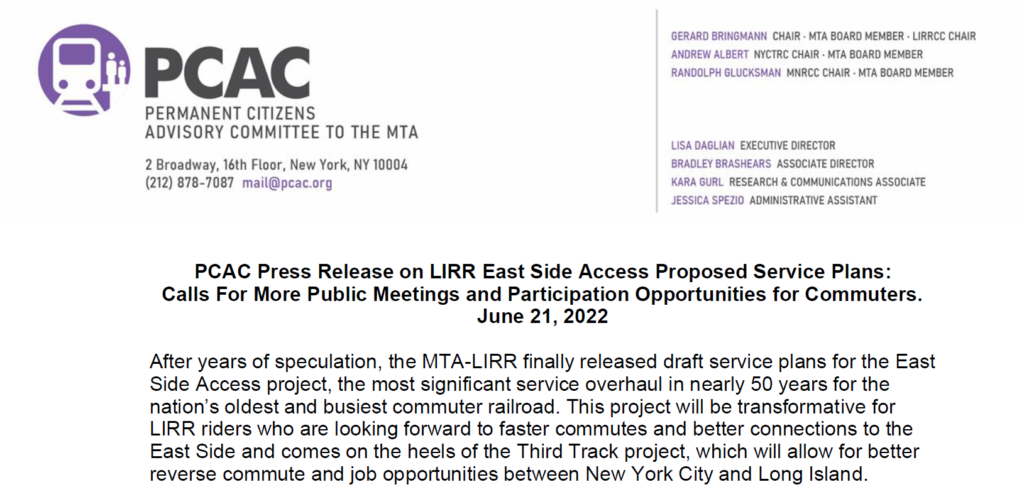After years of speculation, the MTA-LIRR finally released draft service plans for the East Side Access project, the most significant service overhaul in nearly 50 years for the nation’s oldest and busiest commuter railroad. This project will be transformative for LIRR riders who are looking forward to faster commutes and better connections to the East Side and comes on the heels of the Third Track project, which will allow for better reverse commute and job opportunities between New York City and Long Island.
To allow it to be truly transformational on a regional level, extensive interagency coordination among LIRR, Metro-North, and New York City Transit is essential to ensure that riders from Montauk to Grand Central to Wassaic have smooth connections around the region, especially in advance of congestion pricing and the ongoing push to get people out of their cars and back on trains. We’re confident that such coordination can ‒ and will – occur, but robust input from riders is critical to making sure that commuters have the service they want and need. New service to Grand Central must deliver on decades of promises, while also ensuring that those who want to continue riding to Penn Station have ample service, and that the Lex and Broadway/7th Avenue lines can absorb the new demand. Ease of accessing new schedules will also be important to getting riders onboard to the changes, and we were glad to see the new app configuration that will allow people to better see connections and time their transfers.
With such significant changes proposed for LIRR service, riders deserve an extensive public engagement process with ample opportunity to have their voices heard. With three information sessions and only one meeting currently scheduled for riders to speak, the MTA should add additional public meetings or hearings to listen to riders. Similar to the location-based robust Queens and Bronx Bus Network Redesign public meetings, the MTA should ideally hold these public sessions as branch-by-branch meetings for more detailed information sharing and rider input. For some Penn Station-bound riders who may feel misled about the promise of better service, the new service plan may feel more like a cut with fewer trains to Penn than an addition of trains to Grand Central. Riders need additional opportunities to express these and other concerns before the service plan is finalized, with assurances that the MTA is listening.
One of the biggest changes in the new approach to scheduling is the loss of direct transfers at Jamaica for many riders. While the app will help people see what options they have, missing connections for trains that have long gaps in service – especially those in diesel territory – could add an extra hour or more to an eastbound trip. For riders heading westbound and continuing onto Penn Station or Grand Central, there will be adjustments as people figure out their next best train. Riders going to Atlantic Terminal won’t be as lucky: the long-awaited – and dreaded – Platform F will be coming online to serve as the basis for the shuttle-esque “scoot service” with potentially longer wait times at Jamaica that seems to be the future of Brooklyn service. This will be particularly challenging for disabled riders and people with luggage and is especially disappointing since we have long been assured that Atlantic Terminal destinations wouldn’t be relegated to a shuttle at the farthest outpost of Jamaica station. With so many jobs, schools, sports and fast connections to lower Manhattan, riders to and from Brooklyn, Long Island and Queens alike need good access and mobility options. Getting to Brooklyn shouldn’t be so onerous that riders instead simply give up, stay on their train to whichever Manhattan terminal it’s destined, and then get on already crowded subway lines to complete their trip. We hope to see additional direct, one-seat rides to Atlantic Terminal, as well as service increases to allow for faster and easier connections.
There is a lot to digest with the new draft service plan, and riders understandably have questions – not just about how changes will affect their commutes, but also how planned construction in the coming months and years might further change their day-to-day back and forth. What is the schedule for Port Washington Yard expansion, and will that improve what appear to be increases in travel time along that branch? How will service change after upcoming East River tunnel repairs and with the arrival of new M9A rolling stock? Has there been a forecast of possible increases in Lex and Broadway/7th Avenue line ridership and what that will mean to an already-crowded commute for many? As new ridership and commuting patterns emerge with LIRR trains to Grand Central, we hope that there will be an adjustment period after which the MTA will revise schedules according to ridership volume and needs.
Riders have many thoughts about East Side Access, and many reasons to be excited. But we also have many questions. We appreciate the initial meetings the MTA has set up but are asking the MTA for more public engagement sessions to better inform the LIRR East Side Access service plan – and service to all LIRR destinations – and ensure that riders get the service they need and deserve. Commuters and occasional riders have questions and it’s important all voices are heard.
CONTACT: Kara Gurl, PCAC: 718-839-3625/ [email protected] Lisa Daglian, PCAC: 917-612-2292/ [email protected]
